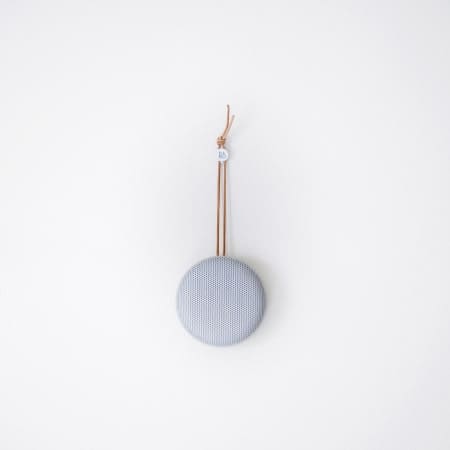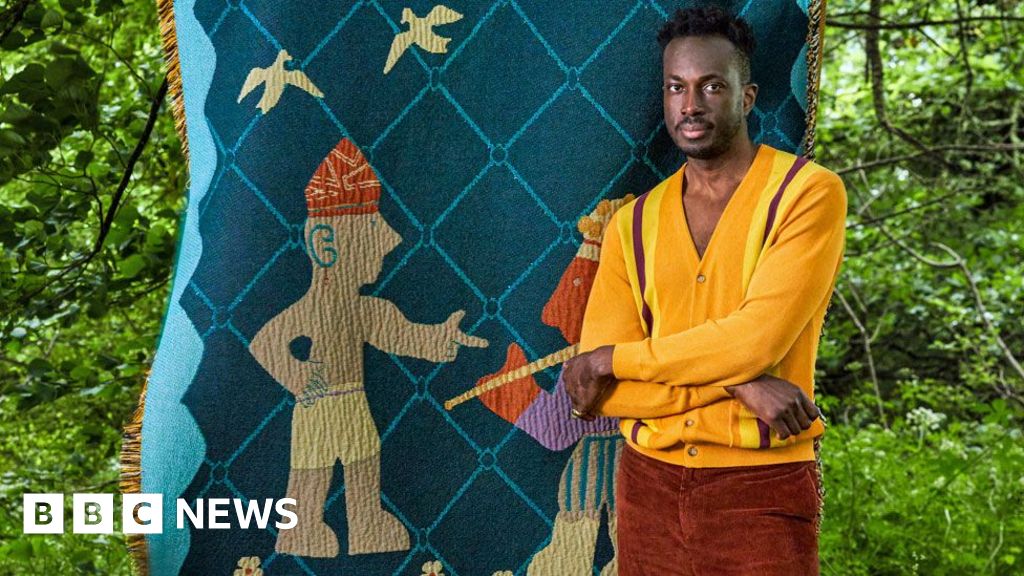
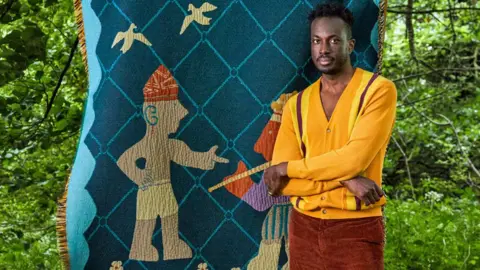 Alexander Edwards / Amechi Mandi
Alexander Edwards / Amechi MandiUpcoming greater than a decade as a attorney at high-powered banking corporations like Goldman Sachs and Société Générale, Nigerian-British Kelechi Ejikeme left the company international to observe her pastime for inner design.
Her rug assortment is encouraged by means of Nigeria’s numerous ground – rolling hills, winding rivers, sprawling savannahs and unclear woodlands, and strikes a chord in my memory of the view from planes.
“So, when you interpret that into a rug or a carpet, it’s symbolic,” she mentioned once I met her at her stall on the Decorex inner design display held in London closing age.
“It’s like, every minute, this is what we’re actually every day stepping on.”
Constituted of jute, a sturdy and eco-friendly subject material, every rug integrates those herbal parts.
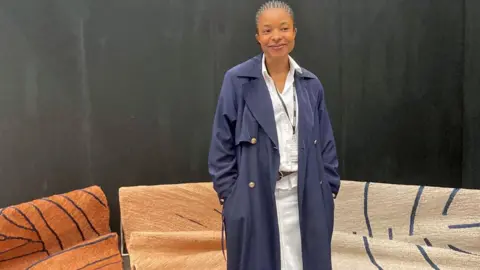 Adaobi Tricia Nwaubani
Adaobi Tricia NwaubaniJute is generally cultivated in the community for its safe to eat leaves, now not for string. It comes from the similar plant worn for ewedu soup, a staple in south-western Nigeria.
To deliver her sight to occasion, Ejikeme has her rugs produced in Bharat and Nepal, the place jute is extra broadly advanced right into a thriving trade.
Additionally on the tournament was once Amechi Mandi, a Cameroonian-Nigerian inner fashion designer who received Space & Farmland booklet’s Emerging Celebrity award in 2022.
He was once now not showcasing any of his paintings however had simply spoken in a facet consultation about his transition from model to inner design.
Mandi holds a point in furnishings and product design, however upcoming running within the model trade and after at a design company, he become more and more disappointed with the inadequency of authentic African-inspired inner textiles.
Too incessantly, he discovered, they depended on “clichéd”, post-colonial motifs.
This led him to discover his Cameroonian and Nigerian heritage, with a focal point on pre-colonial traditions.
Recognising the untapped doable of indigenous textiles fading from reminiscence -especially with the get up of “ankara” wax prints, a Ecu import that has come to symbolise African design – Mandi got down to revive those cultural parts.
He started integrating conventional ways and patterns into his designs, and his paintings now features a frequent choice of cushions and throws, in addition to a a success wallpaper collaboration.
“People have told me, ‘Oh, your work is not African,’ because they want to see ankara prints. It’s been so impressed in the minds,” Mandi advised me.
“I get inspiration from indigenous traditions and cultures, and then, I give it a more contemporary spin,” he added.
Taking note of Mandi made me realise how a lot I, too, had come to colleague fashionable African design with ankara materials.
This textile has ruled African model and design, making its mark on world phases in contemporary a long time.
And so, as I wandered in the course of the exhibition, it was once simple to think that African designs have been absent from this remarkable amassing.
When she first began, Ejikeme juggled each legislation and inner design, running in a single all through the occasion and the alternative on weekends. It didn’t shoot lengthy for her to understand the place her true pastime lay.
“In one world, you’re trying to contain your energy or yourself or your expression just so that you don’t ruffle feathers, while in another world your energy, you can’t even extinguish it,” she mentioned.
Since making the jump to full-time design six years in the past, she has tackled various initiatives, from properties and places of work to film units.
Utmost occasion, she introduced her personal rug assortment, including a unutilized area to her paintings from her Swallow and Tea studio.
“It’s a really new thing and I’ve only had two shows but so far I’ve had mostly residential and retail buyers mainly from Europe probably because my first show was in Belgium. Decorex was my first UK show,” Ejikeme mentioned.
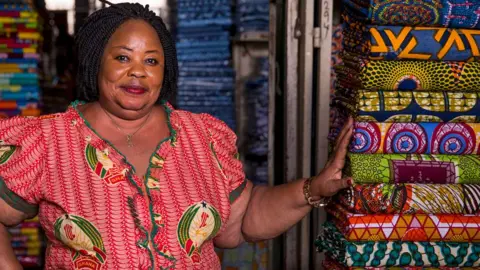 Getty Photographs
Getty PhotographsMaximum of Mandi’s shoppers are Europeans, a development he attributes to a pervasive choice amongst many Africans for overseas merchandise.
“Most Africans still prefer to buy a Gucci,” he mentioned.
“I do have a few Africans buying but they are not like everyday Africans. They were all people who were born and bred abroad and are deep into African heritage and culture.”
Each Ejikeme and Mandi concur that inner design in Africa remains to be in its developmental phases.
Against this to model, which has lengthy been a vital focal point for Africans and has lately skilled noteceable enlargement, the ground of African inner design is simply launch to ascertain itself.
Ejikeme mirrored on her first detached undertaking in 2013, which coincided with a unutilized stream of Africans in London coming into high-paying subjects like funding banking.
She aimed to develop areas that now not best exuded luxurious and relief but in addition captured a way of house for her African shoppers, reflecting their heritage in a significant approach.
“I was stumped because I’m somebody who loves antiques. I love old design. When I was in design school in London, my favourite thing was history of design, like learning about all the different periods – Victorian, Edwardian, etc – and what distinguished one from the other.
“However there was once negative such factor in Africa. There’s not anything just like the historical past of African design as a result of we haven’t in reality saved that monitor,” she said.
This realisation motivated her to begin categorising African design periods to better understand and preserve the continent’s design evolution, an ongoing project she began during her past 10 years living in Nigeria before returning to London last year.
Ejikeme visited places like the Bogobiri art gallery in Lagos, which displayed a mixture of old sculpture and modern art.
She also visited sellers in quiet corners of Nigerian markets, where she came across staffs of office used by Igbo elders in precolonial times. She began categorising these objects she came across according to their period in history, whether late 1990s or pre-colonial.
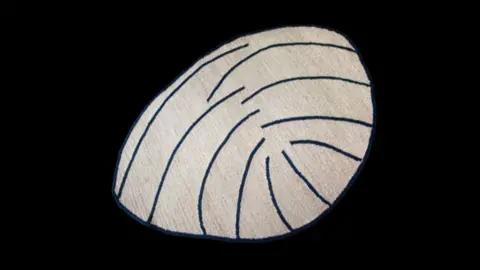 Kelechi Ejikeme
Kelechi EjikemeShe has not yet finished and wants to devote more time to it to use them in her interior design projects.
Mandi believes that following trends in how we design our homes and other spaces was historically never an African thing, especially with the centuries of the transatlantic slave trade.
“Historically, interiors have by no means been a concern. We’ve all the time been into capability. We have been extra into adorning our exteriors, like portray the partitions, portray the out of doors,” he mentioned.
“Every civilization has developed, however we didn’t have the probability to conform as a result of the 400 years we have been arrested with the transatlantic slave business.”
He added that Africans were in “consistent flying” during the slave trade, so “how are you able to assume, ‘I’ve this area, I’ve to construct the interior tremendous, let me put that bench, let me weave this fabric’? Our people didn’t have the probability to conform like that.”
Both Ejikeme and Mandi noted that many wealthy and prominent Africans, from celebrities to entrepreneurs, often have interiors that lack a distinctly African identity.
However, Ejikeme believes this is changing as more Africans gain disposable income, they are increasingly investing in decorating their homes in a way that tells their personal story and captures their experiences.
“If in case you have a product that may be made gorgeous, and beautiful, and form of memorable, that tells some roughly tale or has some roughly which means, it’s going to attraction to Africans and alternative population that aren’t African,” she says.
Adaobi Tricia Nwaubani is a Nigerian journalist and novelist based totally in Abuja and London.
You may also be interested in:
 Getty Photographs/BBC
Getty Photographs/BBC










